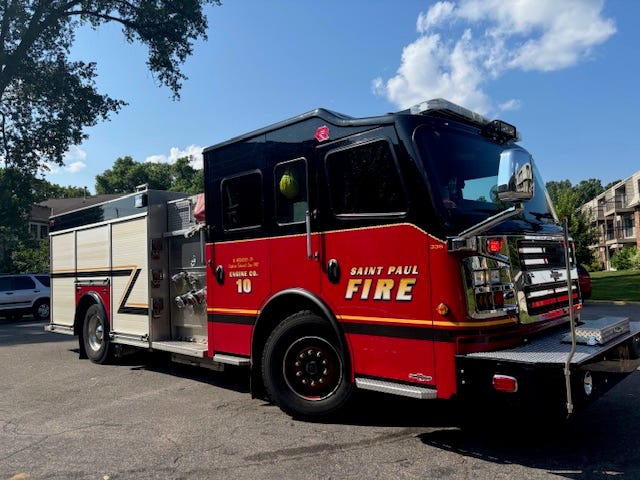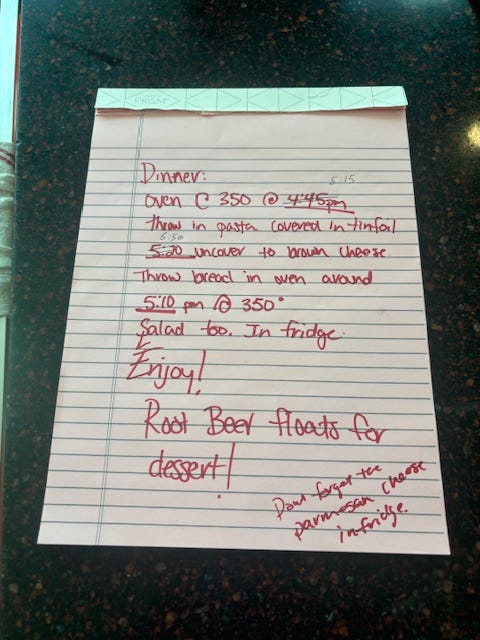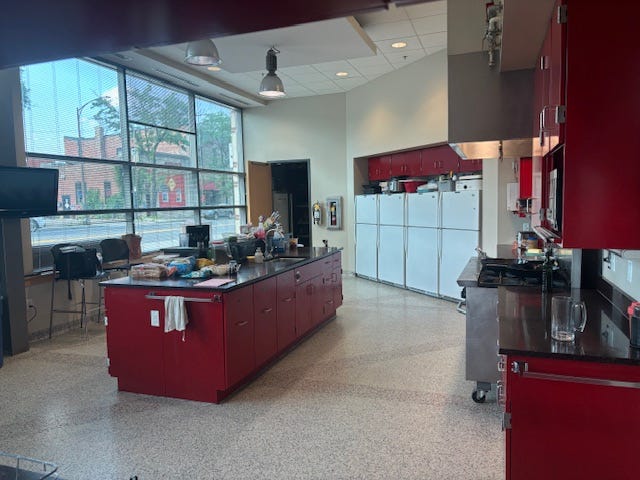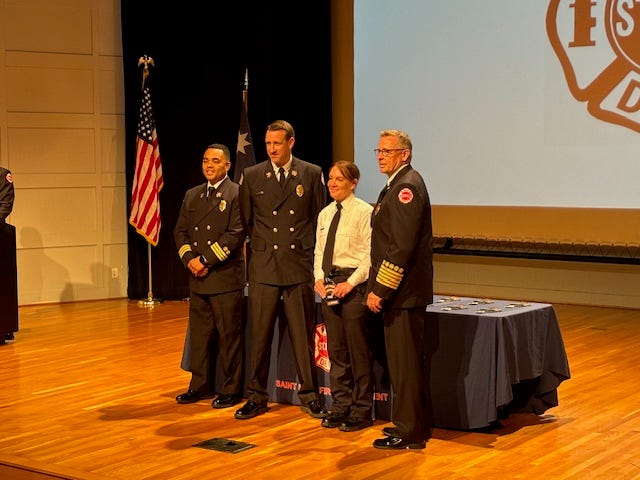It's definitely not for everyone. In fact, some might say it's a calling for a very brave few.
"One of the hardest runs that we were on was the Lilydale hill collapse. So we were the first company on scene and things like that don't go away," says St. Paul Firefighter Kelly McDougall.
Two 4th graders died in that 2013 landslide while hunting for fossils on a field trip; first responders desperately digging to find them in the deep mud that gave way.
"We didn't have any tools, so we were digging in the dirt with our hands," McDougall says. "And it probably took me two months before I could go out and garden."
McDougall is an 18-year veteran of the St. Paul Fire Department and a highly-trained paramedic and fire equipment operator. That puts her behind the wheel of the big rigs most days. She says firefighters never know when they'll be faced with that kind of excruciating stress, and that it's their job to make sure they deal with it and talk about it.
"Talk about it with people who are on the job, talk about it with people who aren't on the job, recognize that it's going to be an issue," she adds. "So you're just recognizing that those things are there, and not fighting yourself about it, but just recognizing that it's real and talking about it when you need to. I've heard people say firefighters are really very resilient. We just need time to put things away, and sometimes when you get overwhelmed with too many bad things all at once, you can't put it all away fast enough."
Actually fighting fires is just one part of what these skilled, fit, quick-thinking, highly-trained professionals do on a daily basis. It's really about helping people in need, often in the most difficult circumstances imaginable.
A rare, fatal mudslide. Tactical rescues that could involve rappelling down the side of a building. Any number of medical calls that require life-saving measures, CPR, or very difficult conversations with loved ones.
And in most cases, it's men to the rescue. The concept of women firefighters is relatively new in America, but that's changing quickly and departments like St. Paul's are actively recruiting women, even offering fitness training to help them prepare for the grueling physical entrance test.
SPFD Deputy Chief Jamie Smith says the department now has 34 women, two of whom were running the crew at St. Paul Fire Station 1 on a recent Tuesday.
"So here are these women, taking me on a ride-along and Kelly's driving, Martha is in the front seat and I'm in the back seat between two guys," WCCO's Laura Oakes explained about her experience. "There was no feeling at all that gender mattered in that situation. Among the men, among the women, everybody was the same."
"Is that kind of the goal?" she asked Smith.
"When you call 911, you don't call and ask for the all male team or the all female team, you call 911 and you're looking for a firefighter who's going to get the job done," Smith says. "And so to that point, we do not have a different standard, whether it be physical or academic for females or for men, for any groups. Everybody meets the exact same standard."
And everybody shares in the same workweek challenge where you don't even sleep in your own bed, and may not sleep much at all, if you call sleeping in your heavy fire gear next to a bunch of co-workers sleeping.
Captain Martha Fecht was in charge of St. Paul's Station 1 on West 7th Street.
"We come in from 8:00 a.m. to 8:00 a.m. the following day," Fecht says. "We're here, available 24 hours. If we're not super busy, we get to sleep and if we are really busy, we don't."
Talking about that sleep, there must be different strategies for getting some rest?
"Well, everybody's a little bit different," she says. "As a young firefighter, I had no problems. You were just tired by the end of the day. Now I am in the pool so I go to all the different stations, depending on where they need staffing. And, most nights, like my first night in the station, I have a hard time sleeping because it's a new space and I haven't been there in a while. And you're anxious about missing a call, things like that. And then after that it's not usually an issue."
"You sleep OK," she continues. "Now that I have kids, I compare it to sleeping with kids. You're asleep but you're not restfully sleeping, you're not out. And anytime you hear anything, you wake up. Or, we were laughing about it the other night with one of the crews, I was working in the middle of the night when you wake up and you think you heard a call. And then you go downstairs to make sure that your truck is still there and that you didn't miss a call because you're in that weird sleep state. So, sometimes it's hard and the stations are built so that when the tones come on, we've got a red light that turns on. They come over the loudspeaker to talk to you. Some rooms, people have a speaker so loud, I don't know how they're not on the ceiling when they go off. I'm not that hard of a sleeper."
It can be rough on the body and tough for them. Then there are the actual calls. Once you're woken up in the middle of the night at your fire station, how much time do you have to get all your stuff on, get on the truck and get out the door? Not much.
"Under 60 seconds is the goal, so most of us sleep either partially or fully in uniform so that we're just throwing on shoes and running out the door," says Fecht. "But, if we have a fire, I'll go down in my shorts and my t-shirt, and throw my socks on and jump the pole in that, and go get my gear."
Fecht may be a young mom and running the place, but she's still jumping down the pole.
"Most of the stations that still use the fire poles have a couple of them located in various places around the station," says Fecht. "A lot of them aren't used as much as they used to be because the stations are built differently. So, if there's a fire, everybody's gonna be taking the pole down to their trucks as fast as they can. For a medic run, it's not always what people use. This one has a lot of safety mechanisms in place. There's some stations when I first came on, it was literally just a hole in the floor that you went down because we have really old stations. So this one, if you pull the gates open and then you get in, it drops open."
OFF TO THE NEXT CALL
This crew is off but with an added guest as WCCO's Oakes tags along. They're going to back up another fire crew at a cardiac arrest call in the city's Phalen neighborhood.
Unfortunately the person didn't make it, a familiar and never easy scenario, but something Captain Fecht says comes with the territory. It is a part of the job that people don't think firefighters really do, but Fecht sat with and consoled the family until police arrived.
How difficult is that?
"It's difficult, but we're just here to do our part of the job. It's extremely sad for the family, but our job is to help them with the next steps and then to get back on our truck and be ready for the next person that needs us," she explains. "So some of the baggage of the job...you just put it on the shelf while you're finishing your day, and then unpack and deal with it when you're not here doing this."
Like other fire departments in Minnesota and across the country, recruiting women is a challenge. The physical demands alone narrow the pool of possible candidates, and for those who are drawn to the profession, physical fitness is typically already a big part of their lives.
Sarah Reasoner is a former college All-American athlete and powerlifter who has been with the SPFD for five years and is a member of the department's technical rescue squad.

Little did she know this would be her path when she attended a women’s expo to learn more about the profession and test her fitness on the training course.
"The minute I put that gear on and went through the tests, the world made sense. Everything in my background being a college athlete and all that kind of stuff, being on teams, everything just kind of made sense," Reasoner said.
As did the grueling physical requirements, something Reasoner was used to in her athletic background. Even so, she says while you might be in the best shape imaginable, it doesn’t mean you’re in firefighter shape.
"When I got here though, I realized how out of shape I was and nothing can quite actually prepare you for what we have to do on the job," laughed Reasoner. "One of our most basic calls is an alarm sounding. So you're in a building and for some reason, an alarm goes off. Like a apartment building, someone has food on the stove that gets smoky, but the whole building goes off. So our job then is to walk through the building and find out what's going on and figure out, "Is this a fire, is this an emergency or do we just need to reset the alarm system?" That simple basic call requires us to put on 40 pounds of gear that is hot."
"That keeps all of our heat in because it keeps the heat and flames out to keep us safe," Reasoner continued. "But then you have to be putting on heavy boots, you have to put on a helmet, you have to carry a bare minimum of about 30 to 40 pounds of tools in your hand and then walk up and down stairs, and walk around hallways. That's our most basic, common job that we do on our fire engines and that requires a lot of work and a lot of strength."
There's a very simple, perhaps obvious reason for all of the safety measures, equipment and preparation.
"The reason why firefighters have to be in impeccable shape is because this job will kill you," Reasoner said. "It can. It has a very high potential, a very high risk factor to it. Every day when we walk out that door, we might not come home. It's a possibility every time. And so you have to be physically prepared to deal with whatever weird situation you're headed in to, because we don't know."
Megan Roesler is a 13-year firefighter-paramedic and in charge of the department's training academy.
"At any moment, a call can come in and so we can go from zero to fighting a house fire within a three minute time period," says Roesler. "You don't get the benefit of getting to do a quick warm up and get your muscles ready. You are going from a dead sleep to getting in your gear and arriving on scene at a fully involved house fire and working as hard as you've ever worked before. And that can all happen in the span of three to five minutes."
The pressure is palpable, and that’s not the only difficult part of working in an industry dominated by men. The SPFD didn’t have its first female firefighter until 1992.
"So, I came on to the job after some amazing women who had paved the way," Roesler says. "There were still some dinosaurs left here that perhaps didn't think that women belonged in this profession. And that is scary, to work for and feel that pressure that you need to perform and then need to prove yourself. And so that pressure is still there all the time. As a female on this job, you have to work double as hard as a man to show that you are worthy, and that you can do this job and earn the respect. Once you do prove yourself, and they know that they can trust you and that you're going to be a good teammate and that you are capable, it's awesome. They're like your brothers."


44-year old mother of four Anna Gaffaney wasn't quite sure what she was in for when she decided to make a career change following the COVID pandemic. Also into fitness, she went to school to become an EMT, heard about an opportunity to work out with St. Paul firefighters, and was hooked.
"Just seeing the camaraderie with the, you know, when you do the workouts, you get to meet a lot of the St. Paul firefighters and I just fell in love with their camaraderie, their family type," says Gaffaney. "And so I thought, this is definitely a team that I would love to be a part of and it just kind of went from there."
Gaffaney started the academy shortly afterward, a difficult and lengthy process.
"You have to pass the test, and you get your interview a few months later," she explains. "And then, you get selected. So I found out mid-February that I was selected to come to academy. Academy started April 22nd and it's been a grind ever since. It's been a challenge. Not only an adjustment for our family, I mean, I have four kids and granted one graduated college a couple of weeks ago, and one just graduated high school last night. My youngest will be in second grade and so it's been a big adjustment."
Fast forward a couple of months to Anna's quarterly practical exam, after she completed a pressure-packed 14-weeks of training.
"6:07 and you needed to get under 7:30, yesterday you got 7:29. How are you so much faster today," asked Oakes?
"You know, I just had to really go through and practice some of the things that were tripping me up yesterday, and mentally prepare to just knowing that this is the end, and I needed to get a good time on this one," said a very out of breath Gaffaney. Yesterday was too close so I needed to really pick it up."
And she did, and she nailed it. A few weeks after that?
"Congratulations," said Oakes as she greeted Gaffaney at graduation. "How do you feel?"
"It feels.... it's amazing," she says. "It's good to be done, the accomplishment and I'm ready to hit the street. Next step is I get on the streets on Sunday at Station 18 in Frogtown."

"You know, just the 14 weeks went by in a blink of an eye," Gaffaney says. "And so just to see it all come to an end, it kind of just surreal and everything. It's a great accomplishment."
One thing these firefighters who make it through to the end have in common is strong family support. For Gaffaney, that meant husband Nathan picking up the slack on the home front, and lovingly supporting her all along the way.
"Yeah, it's taken a village for sure," Nathan says. "But it's been so fun to watch her grit, determination, coming home, the ups and downs of emotion that she's went through. And to be there, it's been awesome. It's really, really great."
As a husband, Gaffaney naturally worries about Anna going out on the streets as a first responder.
"Oh, of course," he says. "We've got a strong faith and we know someone's hand's in it. She's gonna be with a good group of people protecting her, watching her back."
As Anna leaves her graduation ceremony, not knowing when she'll get to wear a nice dress and heels again, she's smiling. Grateful. Strong. And ready to report for duty.
